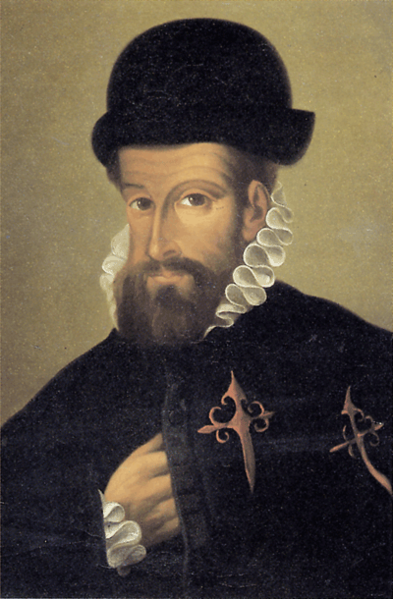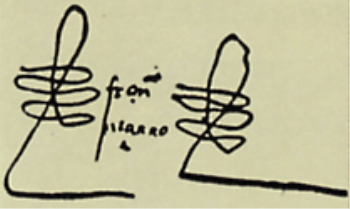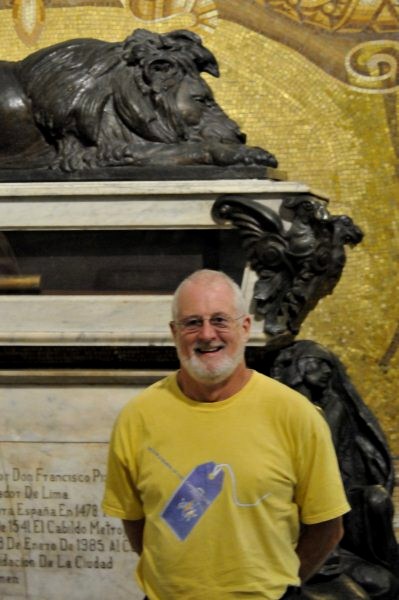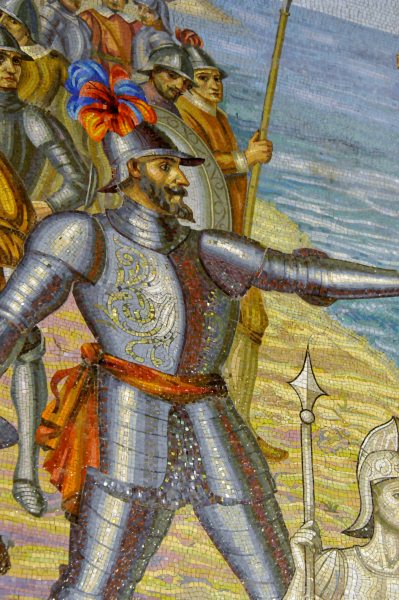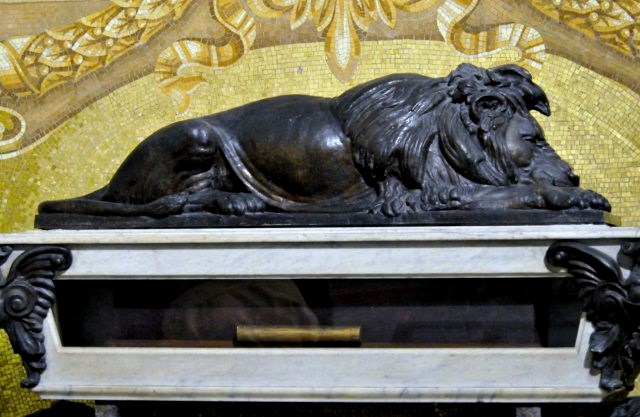Pizarro

|
Francisco Pizarro
Francisco Pizarro y González, 1st Marquess of los Atabillos. 1471 or 1476 – 26th June 1541 was a Spanish conquistador, conqueror of the Incan Empire and founder of Lima, the modern-day capital of Peru.
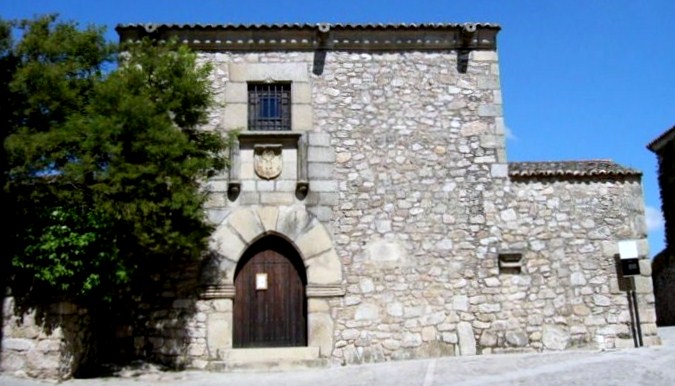 Early life: Pizarro was born in the town of Trujillo, Spain. He was an illegitimate son of Gonzalo Pizarro Rodríguez de Aguilar (senior) (1446–1522) who
was colonel of infantry served in the Italian
campaigns. His mother was Francisca González Mateos, a woman of slender means
from Trujillo, daughter of Juan Mateos. Expedition to the Americas: On the 13th of February 1502, he sailed from Spain with the newly appointed Governor of Hispaniola, Nicolás de Ovando y Cáceres, on a fleet of thirty ships. It was the largest fleet that had ever sailed to the New World carrying two and a half thousand colonists.
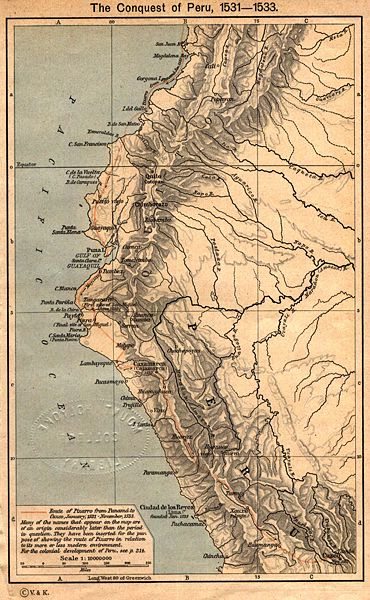 Expeditions to South America: The first attempt to explore western South America was undertaken in
1522 by Pascual
de Andagoya. The native South Americans he encountered told him about a
gold-rich territory called Virú, which was on a river called Pirú (later
corrupted to Perú) and from which they came. These reports were related by the
Spanish-Inca mestizo writer Garcilaso
de la Vega in his famous Comentarios
Reales de los Incas (1609). First expedition: On the 13th of September 1524, the first of three
expeditions left from Panama for the conquest of Peru with about eighty men and
forty horses. Diego de Almagro was left behind because he was to recruit men,
gather additional supplies, and join Pizarro later. The governor of Panama,
Pedro
Arias Dávila, at first approved in principle of exploring South America.
Pizarro's first expedition, however, turned out to be a failure as his
conquistadors, sailing down the Pacific coast, reached no farther than Colombia
before succumbing to such hardships as bad weather, lack of food, and skirmishes
with hostile natives—one of which caused Almagro to lose an eye by arrow-shot.
Moreover, the place names the Spanish bestowed along their route, including
Puerto deseado (desired port),
Puerto del hambre (port of
hunger) and Puerto quemado
(burned port), only confirm their straits. Fearing subsequent hostile encounters
like the one the expedition endured at the Battle
of Punta Quemada, Pizarro chose to end his tentative first expedition and return to
Panama. Second expedition (1526): Two years after the first very unsuccessful expedition, Pizarro,
Almagro, and Luque started the arrangements for a second expedition with
permission from Pedrarias Dávila. The governor, who himself was preparing an
expedition north to Nicaragua, was reluctant to permit another expedition, having lost confidence
in the outcome of Pizarro's expeditions. The three associates, however,
eventually won his trust and he acquiesced. Also by this time, a new governor
was to arrive and succeed Pedrarias Dávila. This was Pedro
de los Ríos, who took charge of the post in July of 1526 and had manifested his
initial approval of Pizarro's expeditions (he would later join him several years
later in Peru). In August 1526, after all preparations were ready, Pizarro left
Panama with two ships with 160 men and several horses, reaching as far as the
Colombian San Juan River. Soon after arriving the party separated, with Pizarro
staying to explore the new and often perilous territory off the swampy Colombian
coasts, while the expedition's second-in-command, Almagro, was sent back to
Panama for reinforcements. Pizarro's Piloto Mayor (main pilot), Bartolomé
Ruiz, continued sailing south and, after crossing the equator, found and captured a balsa (raft) of natives from
Tumbes who were supervising the area. To everyone's surprise, these carried
a load of textiles, ceramic objects, and some much-desired pieces of gold,
silver, and emeralds, making Ruiz's findings the central focus of this second expedition
which only served to pique the conquistadors' interests for more gold and land.
Some of the natives were also taken aboard Ruiz's ship to serve later as
interpreters. He then set sail north for the San Juan river, arriving to find
Pizarro and his men exhausted from the serious difficulties they had faced
exploring the new territory. Soon Almagro also sailed into the port with his
vessel laden with supplies, and a considerable reinforcement of at least eighty
recruited men who had arrived at Panama from Spain with the same expeditionary
spirit. The findings and excellent news from Ruiz along with Almagro's new
reinforcements cheered Pizarro and his tired followers. They then decided to
sail back to the territory already explored by Ruiz and, after a difficult
voyage due to strong winds and currents, reached Atacames in the Ecuadorian coast. Here they found a very large native
population recently brought under Inca rule. Unfortunately for the
conquistadors, the warlike spirit of the people they had just encountered seemed
so defiant and dangerous in numbers that the Spanish decided not to enter the
land. The Thirteen of the Fame: After much wrangling between Pizarro and Almagro, it was decided that
Pizarro would stay at a safer place, the Isla de Gallo, near the coast, while
Almagro would return yet again to Panama with Luque for more reinforcements —
this time with proof of the gold they had just found and the news of the
discovery of an obvious wealthy land they had just explored. The new governor of
Panama, Pedro de los Ríos, had learned of the mishaps of Pizarro's expeditions
and the deaths of various settlers who had gone with him. Fearing an
unsuccessful outcome, he outright rejected Almagro's application for a third
expedition in 1527. In addition, he ordered two ships commanded by Juan Tafur to
be sent immediately with the intention of bringing Pizarro and everyone back to
Panama. The leader of the expedition had no intention of returning, and when
Tafur arrived at the now famous Isla
de Gallo, Pizarro drew a line in the sand, saying: "There lies Peru with its riches; Here,
Panama and its poverty. Choose, each man, what best becomes a brave
Castilian." Only thirteen men decided to stay with Pizarro and later
became known as The Famous
Thirteen ("Los trece de la fama"), while the rest of the expeditioners
left back with Tafur aboard his ships. Ruiz also left in one of the ships with
the intention of joining Almagro and Luque in their efforts to gather more
reinforcements and eventually return to aid Pizarro. Soon after the ships left,
the thirteen men and Pizarro constructed a crude boat and left nine miles north
for La Isla Gorgona, where they
would remain for seven months before the arrival of new provisions. Pizarro's third and final expedition left Panama for Peru on the 27th
of December 1530. Conquest of Peru: In 1532 Pizarro once again landed in the coasts near Ecuador, where some gold, silver, and emeralds were procured and then dispatched to Almagro, who had stayed in Panama to gather more recruits. Though Pizarro's main objective was to then set sail and dock at Tumbes like his previous expedition, he was forced to confront the Punian natives in the Battle of Puná, leaving three Spaniards dead and 400 dead or wounded Punians. Soon after, Hernando de Soto, another conquistador that had joined the expedition, arrived to aid Pizarro and with him sailed towards Tumbes, only to find the place deserted and destroyed. Their two fellow conquistadors expected they had disappeared or died under murky circumstances. The chiefs explained the fierce tribes of Punians had attacked them and ransacked the place. As Tumbes no longer afforded the safe accommodations Pizarro sought, he decided to lead an excursion into the interior of the land and established the first Spanish settlement in Peru (third in South America after Santa Marta, Colombia in 1526), calling it San Miguel de Piura in July 1532. The first repartimiento in Peru was established here. After these events, Hernando de Soto was dispatched to explore the new lands and, after various days away, returned with an envoy from the Inca himself and a few presents with an invitation for a meeting with the Spaniards.
 Following the defeat of his brother, Huascar, Atahualpa had been resting in the Sierra of northern Peru, near Cajamarca, in
the nearby thermal baths known today as the Baños del Inca (Incan Baths). After
marching for almost two months towards Cajamarca, Pizarro and his force of just
106 foot-soldiers and 62 horsemen arrived and initiated proceedings for a
meeting with Atahualpa. Pizarro sent Hernando de Soto, friar Vicente
de Valverde and native interpreter Felipillo to approach Atahualpa at
Cajamarca's central plaza. Atahualpa, however, refused the Spanish presence in
his land by saying he would "be no man's tributary." His complacency, because
there were fewer than 200 Spanish as opposed to his 80,000 soldiers sealed his
fate and that of the Incan empire. Atahualpa's refusal led Pizarro and his force to attack the Incan
army in what became the Battle
of Cajamarca on 16 November 1532. The Spanish were successful and Pizarro
executed Atahualpa's 12-man honor guard and took the Inca captive at the
so-called ransom
room. Despite fulfilling his promise of filling one room
22 feet by 17 feet with gold and two with silver, Atahualpa
was convicted of killing his brother and plotting against Pizarro and his
forces, and was executed by garrote on the 26th of July 1533. Pizarro wished to find a reason for
executing Atahualpa without angering the people he was attempting to
subdue. A year later, Pizarro invaded Cuzco with indigenous troops and with it sealed the conquest of Peru. It
is argued by some historians that the growing resistance from the new Inca,
Manco
Inca Yupanqui, prolonged the conquest. Manco Inca Yupanqui was the brother of the
puppet ruler, Tupac
Huallpa. During the exploration of Cuzco, Pizarro was impressed and through
his officers wrote back to King Charles
I of Spain, saying: "This
city is the greatest and the finest ever seen in this country or anywhere in the
Indies... We can assure your Majesty that it is so beautiful and has such fine
buildings that it would be remarkable even in Spain." After the Spanish had sealed the conquest
of Peru by taking Cuzco in 1533, Jauja in the fertile Mantaro
Valley was established as Peru's provisional capital in April 1534. But it
was too far up in the mountains and far from the sea to serve as the Spanish
capital of Peru. Pizarro thus founded the city of Lima in Peru's central coast on 18 January 1535, a foundation that he
considered as one of the most important things he had created in life. After the
final effort of the Inca to recover Cuzco had been defeated by Almagro, a dispute occurred between him and Pizarro respecting the limits of
their jurisdiction. This led to confrontations between the Pizarro
brothers and Almagro, who was eventually defeated during the Battle
of Las Salinas (1538) and executed. Almagro's son, also named Diego and known as
"El Mozo", was later stripped
of his lands and left bankrupt by Pizarro. Pizarro's death: In Lima, Peru on 26 June 1541 "a group of twenty heavily armed supporters of Diego Almagro II stormed Pizarro's palace, assassinated him, and then forced the terrified city council to appoint young Almagro as the new governor of Peru", according to Burkholder and Johnson. "Most of Pizarro's guests fled, but a few fought the intruders, numbered variously between seven and 25. While Pizarro struggled to buckle on his breastplate, his defenders, including his half-brother Alcántara, were killed. For his part Pizarro killed two attackers and ran through a third. While trying to pull out his sword, he was stabbed in the throat, then fell to the floor where he was stabbed many times." Pizarro (who now was maybe as old as 70 years, and at least 62), collapsed on the floor, alone, painted a cross in his own blood and cried for Jesus Christ. He reportedly cried: Come my faithful sword, companion of all my deeds He died moments after. Diego de Almagro the younger was caught and executed the following year after losing the battle of Chupas.

Pizarro's remains were briefly interred in the cathedral courtyard; at some later time his head and body were separated and buried in separate boxes underneath the floor of the cathedral. In 1892, in preparation for the anniversary of Columbus' discovery of the Americas, a body believed to be that of Pizarro was exhumed and put on display in a glass coffin. However, in 1977 men working on the cathedral's foundation discovered a lead box in a sealed niche, which bore the inscription "Here is the head of Don Francisco Pizarro Demarkes, Don Francisco Pizarro who discovered Peru and presented it to the crown of Castile." A team of forensic scientists from the United States, led by Dr. William Maples, was invited to examine the two bodies, and they soon determined that the body which had been honored in the glass case for nearly a century had been incorrectly identified. The skull within the lead box not only bore the marks of multiple sword blows, but the features bore a remarkable resemblance to portraits made of the man in life.
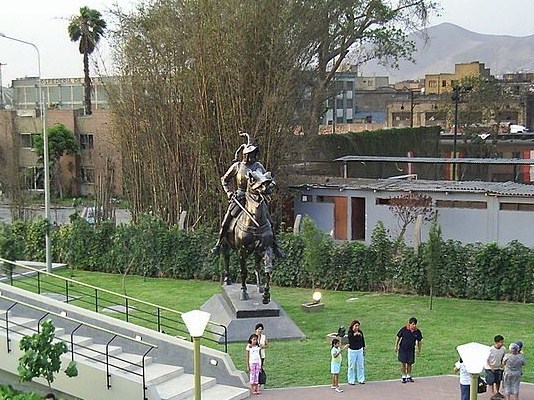 Pizarro's sculptures: In the early 1930s, sculptor Ramsey MacDonald created three copies of
an anonymous European foot soldier resembling a conquistador with a helmet,
wielding a sword and riding a horse. The first copy was offered to Mexico to
represent Hernán Cortés, though it was rejected. Since the Spanish conquerors
had the same appearance with helmet and beard, the statue was taken to Lima in
1934. One other copy of the statue resides in Wisconsin. The mounted statue of
Pizarro in the Plaza Major in Trujillo, Spain was created by Charles Rumsey, an
American sculptor. It was presented to the city by his widow in 1926.
In 2003, after years of lobbying by indigenous and mixed-raced
majority requesting for the equestrian statue of Pizarro to be removed, the
mayor of Lima, Luis
Castañeda Lossio, approved the transfer of the statue to another location: an
adjacent square to the country's Government
Palace. Since 2004, however, Pizarro's statue has been placed in a
rehabilitated park surrounded by the recently restored 17th century pre-Hispanic
murals in the Rímac
District. The statue faces the Rímac
River and the Government Palace.

The Palace of the conquest: After their return from Peru and notoriously rich, the Pizarro family erected a plateresque-style palace on the corner of the Plaza Mayor in Trujillo, Spain. It was said to have been constructed on the orders of Pizarros daughter, Francisca Pizarro Yupanqui. It became an instant recognizable symbol of the plaza. The opulent palace is structured in four stands, giving it the significance of the coat of arms of the Pizarro family, which is situated at one of its corner balconies displaying its iconographic content. At one of its sides it displays Francisco Pizarro and, at the other, his wife, the Inca princess Inés Huaylas, along with their daughter Francisca Pizarro Yupanqui and her husband Hernando Pizarro. The building's decor includes plateresque ornaments and balustrades.
ALL IN ALL PIZARRO IS INDELIBLY LINKED TO THE HISTORY OF PERU |
